Online Learning Component Design: Student Engagement Strategies
VerifiedAdded on 2022/08/16
|9
|2282
|29
Homework Assignment
AI Summary
This assignment delves into the design of an online learning component, focusing on the integration of online activities within a curriculum. It begins by defining the learning objectives and exploring various assessment methods, such as online forums, to facilitate effective communication and knowledge sharing between teachers and students. The paper emphasizes the importance of aligning online activities with the curriculum to enhance student awareness and performance. It also outlines strategies for engaging students in online environments, including communication through multiple formats, providing diverse learning opportunities, fostering social learning, and offering useful feedback. Furthermore, the assignment evaluates online assessment, highlighting the shift towards student-centered learning and discussing methods for assessing student understanding and providing feedback. Finally, it includes a summary of the story "The Moon in the Earthen Pot," analyzing the narrative's themes and storytelling techniques.
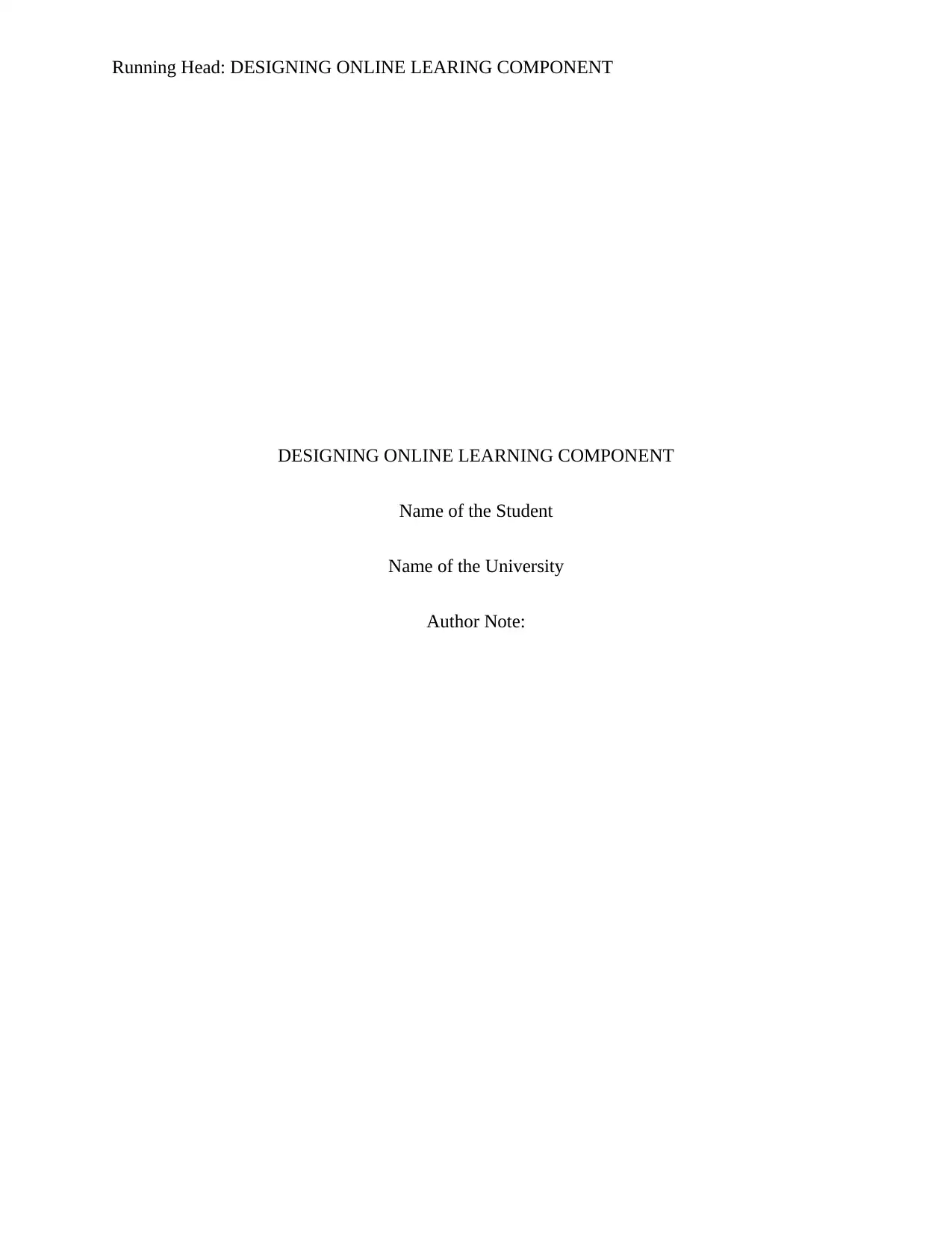
Running Head: DESIGNING ONLINE LEARING COMPONENT
DESIGNING ONLINE LEARNING COMPONENT
Name of the Student
Name of the University
Author Note:
DESIGNING ONLINE LEARNING COMPONENT
Name of the Student
Name of the University
Author Note:
Paraphrase This Document
Need a fresh take? Get an instant paraphrase of this document with our AI Paraphraser
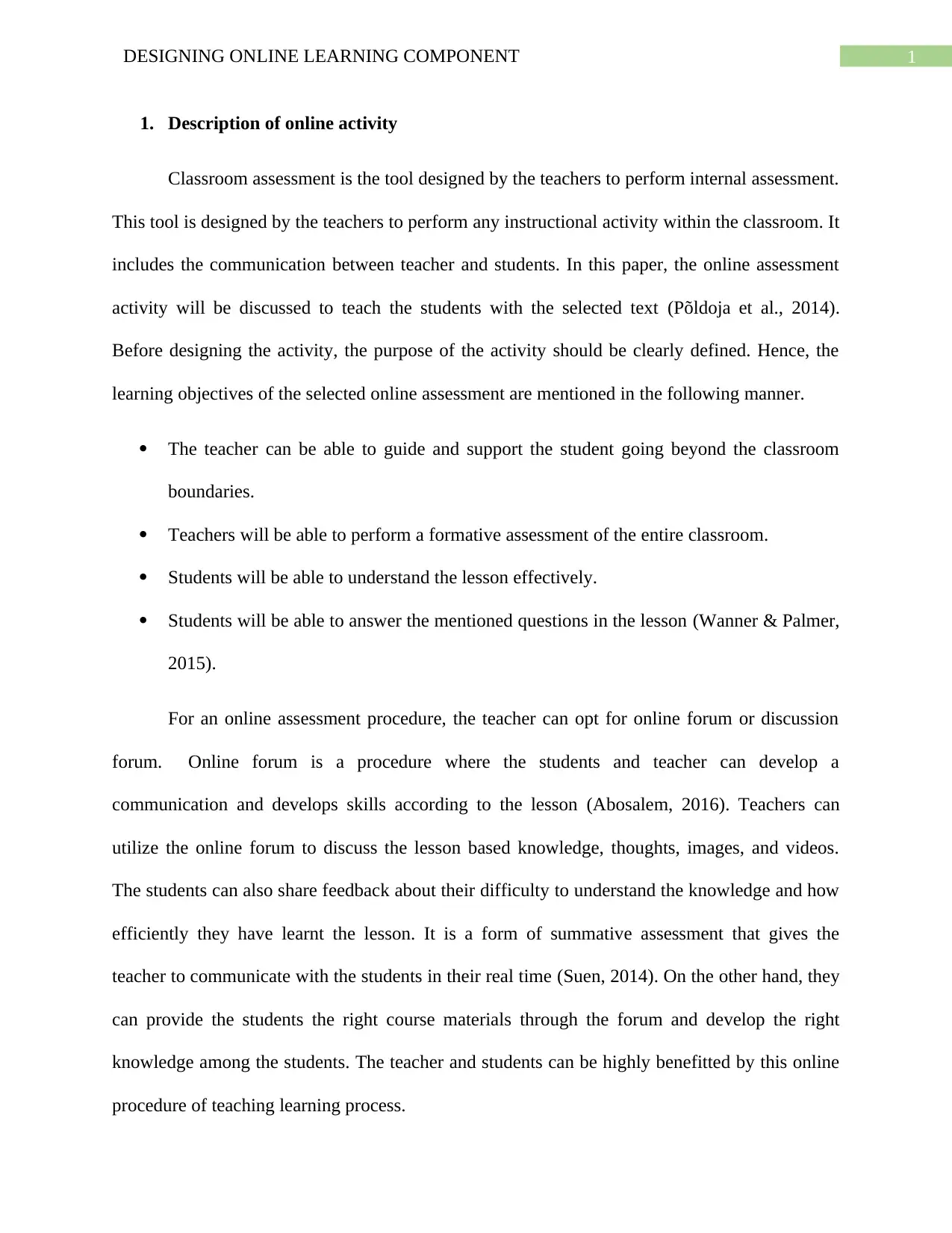
1DESIGNING ONLINE LEARNING COMPONENT
1. Description of online activity
Classroom assessment is the tool designed by the teachers to perform internal assessment.
This tool is designed by the teachers to perform any instructional activity within the classroom. It
includes the communication between teacher and students. In this paper, the online assessment
activity will be discussed to teach the students with the selected text (Põldoja et al., 2014).
Before designing the activity, the purpose of the activity should be clearly defined. Hence, the
learning objectives of the selected online assessment are mentioned in the following manner.
The teacher can be able to guide and support the student going beyond the classroom
boundaries.
Teachers will be able to perform a formative assessment of the entire classroom.
Students will be able to understand the lesson effectively.
Students will be able to answer the mentioned questions in the lesson (Wanner & Palmer,
2015).
For an online assessment procedure, the teacher can opt for online forum or discussion
forum. Online forum is a procedure where the students and teacher can develop a
communication and develops skills according to the lesson (Abosalem, 2016). Teachers can
utilize the online forum to discuss the lesson based knowledge, thoughts, images, and videos.
The students can also share feedback about their difficulty to understand the knowledge and how
efficiently they have learnt the lesson. It is a form of summative assessment that gives the
teacher to communicate with the students in their real time (Suen, 2014). On the other hand, they
can provide the students the right course materials through the forum and develop the right
knowledge among the students. The teacher and students can be highly benefitted by this online
procedure of teaching learning process.
1. Description of online activity
Classroom assessment is the tool designed by the teachers to perform internal assessment.
This tool is designed by the teachers to perform any instructional activity within the classroom. It
includes the communication between teacher and students. In this paper, the online assessment
activity will be discussed to teach the students with the selected text (Põldoja et al., 2014).
Before designing the activity, the purpose of the activity should be clearly defined. Hence, the
learning objectives of the selected online assessment are mentioned in the following manner.
The teacher can be able to guide and support the student going beyond the classroom
boundaries.
Teachers will be able to perform a formative assessment of the entire classroom.
Students will be able to understand the lesson effectively.
Students will be able to answer the mentioned questions in the lesson (Wanner & Palmer,
2015).
For an online assessment procedure, the teacher can opt for online forum or discussion
forum. Online forum is a procedure where the students and teacher can develop a
communication and develops skills according to the lesson (Abosalem, 2016). Teachers can
utilize the online forum to discuss the lesson based knowledge, thoughts, images, and videos.
The students can also share feedback about their difficulty to understand the knowledge and how
efficiently they have learnt the lesson. It is a form of summative assessment that gives the
teacher to communicate with the students in their real time (Suen, 2014). On the other hand, they
can provide the students the right course materials through the forum and develop the right
knowledge among the students. The teacher and students can be highly benefitted by this online
procedure of teaching learning process.
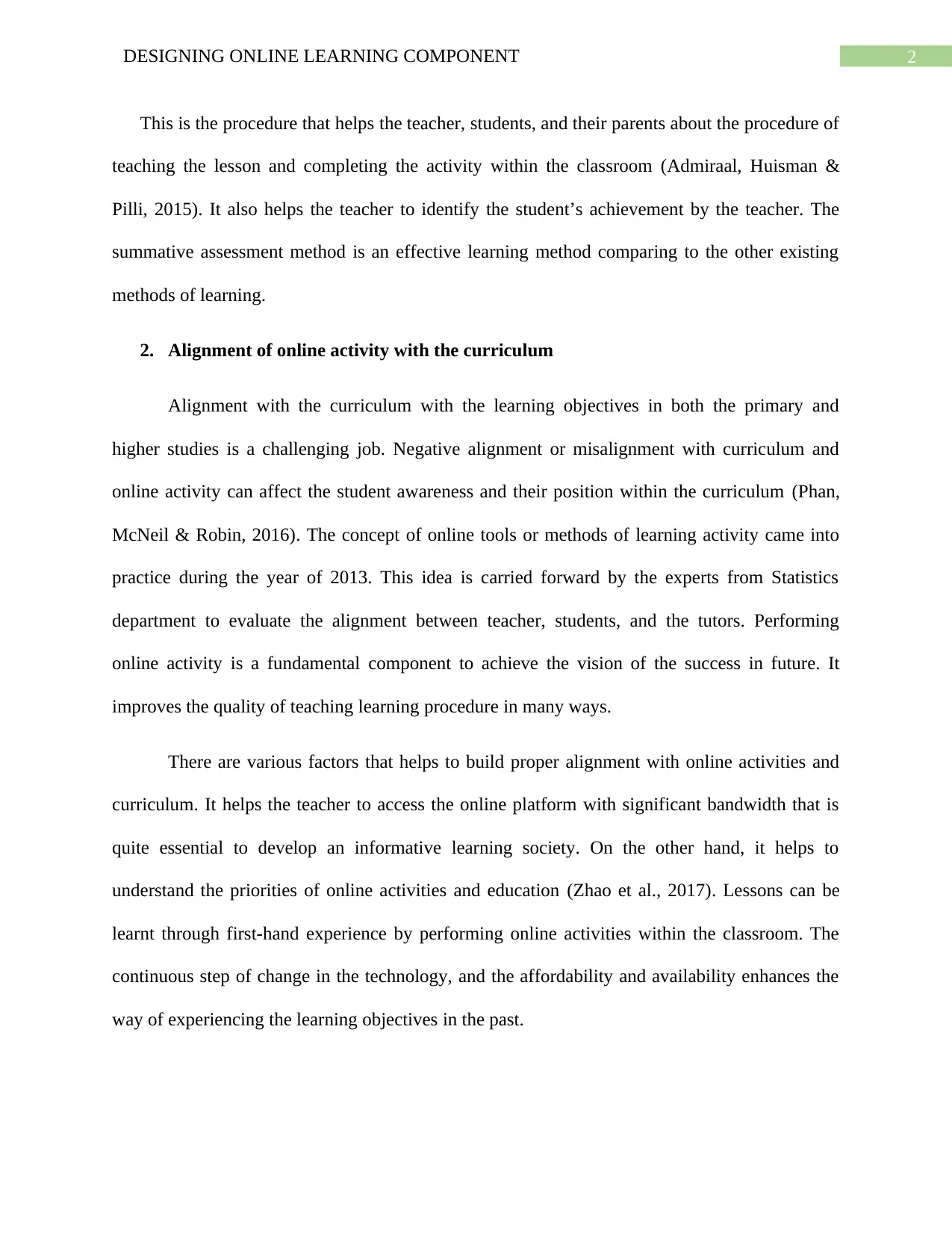
2DESIGNING ONLINE LEARNING COMPONENT
This is the procedure that helps the teacher, students, and their parents about the procedure of
teaching the lesson and completing the activity within the classroom (Admiraal, Huisman &
Pilli, 2015). It also helps the teacher to identify the student’s achievement by the teacher. The
summative assessment method is an effective learning method comparing to the other existing
methods of learning.
2. Alignment of online activity with the curriculum
Alignment with the curriculum with the learning objectives in both the primary and
higher studies is a challenging job. Negative alignment or misalignment with curriculum and
online activity can affect the student awareness and their position within the curriculum (Phan,
McNeil & Robin, 2016). The concept of online tools or methods of learning activity came into
practice during the year of 2013. This idea is carried forward by the experts from Statistics
department to evaluate the alignment between teacher, students, and the tutors. Performing
online activity is a fundamental component to achieve the vision of the success in future. It
improves the quality of teaching learning procedure in many ways.
There are various factors that helps to build proper alignment with online activities and
curriculum. It helps the teacher to access the online platform with significant bandwidth that is
quite essential to develop an informative learning society. On the other hand, it helps to
understand the priorities of online activities and education (Zhao et al., 2017). Lessons can be
learnt through first-hand experience by performing online activities within the classroom. The
continuous step of change in the technology, and the affordability and availability enhances the
way of experiencing the learning objectives in the past.
This is the procedure that helps the teacher, students, and their parents about the procedure of
teaching the lesson and completing the activity within the classroom (Admiraal, Huisman &
Pilli, 2015). It also helps the teacher to identify the student’s achievement by the teacher. The
summative assessment method is an effective learning method comparing to the other existing
methods of learning.
2. Alignment of online activity with the curriculum
Alignment with the curriculum with the learning objectives in both the primary and
higher studies is a challenging job. Negative alignment or misalignment with curriculum and
online activity can affect the student awareness and their position within the curriculum (Phan,
McNeil & Robin, 2016). The concept of online tools or methods of learning activity came into
practice during the year of 2013. This idea is carried forward by the experts from Statistics
department to evaluate the alignment between teacher, students, and the tutors. Performing
online activity is a fundamental component to achieve the vision of the success in future. It
improves the quality of teaching learning procedure in many ways.
There are various factors that helps to build proper alignment with online activities and
curriculum. It helps the teacher to access the online platform with significant bandwidth that is
quite essential to develop an informative learning society. On the other hand, it helps to
understand the priorities of online activities and education (Zhao et al., 2017). Lessons can be
learnt through first-hand experience by performing online activities within the classroom. The
continuous step of change in the technology, and the affordability and availability enhances the
way of experiencing the learning objectives in the past.
⊘ This is a preview!⊘
Do you want full access?
Subscribe today to unlock all pages.

Trusted by 1+ million students worldwide
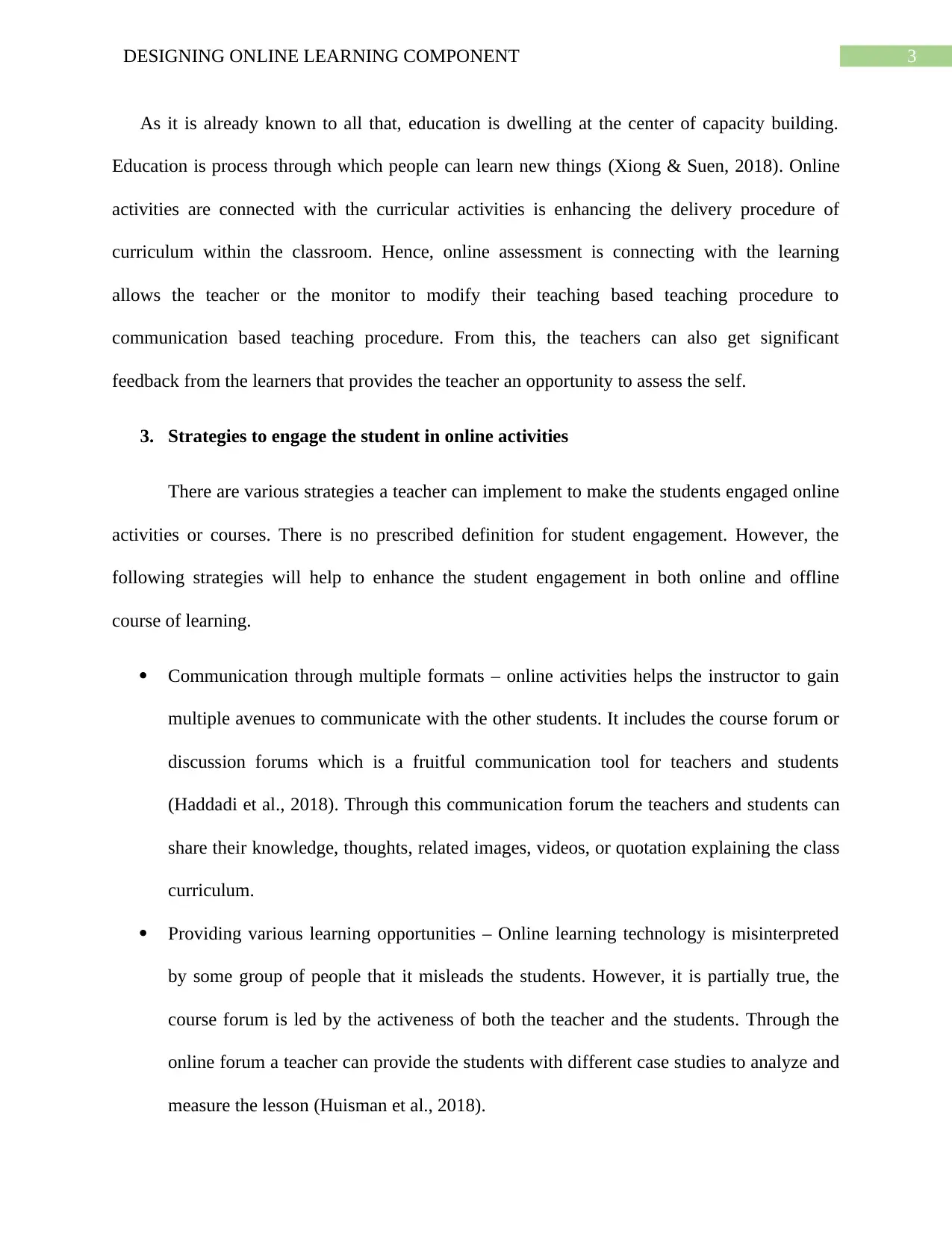
3DESIGNING ONLINE LEARNING COMPONENT
As it is already known to all that, education is dwelling at the center of capacity building.
Education is process through which people can learn new things (Xiong & Suen, 2018). Online
activities are connected with the curricular activities is enhancing the delivery procedure of
curriculum within the classroom. Hence, online assessment is connecting with the learning
allows the teacher or the monitor to modify their teaching based teaching procedure to
communication based teaching procedure. From this, the teachers can also get significant
feedback from the learners that provides the teacher an opportunity to assess the self.
3. Strategies to engage the student in online activities
There are various strategies a teacher can implement to make the students engaged online
activities or courses. There is no prescribed definition for student engagement. However, the
following strategies will help to enhance the student engagement in both online and offline
course of learning.
Communication through multiple formats – online activities helps the instructor to gain
multiple avenues to communicate with the other students. It includes the course forum or
discussion forums which is a fruitful communication tool for teachers and students
(Haddadi et al., 2018). Through this communication forum the teachers and students can
share their knowledge, thoughts, related images, videos, or quotation explaining the class
curriculum.
Providing various learning opportunities – Online learning technology is misinterpreted
by some group of people that it misleads the students. However, it is partially true, the
course forum is led by the activeness of both the teacher and the students. Through the
online forum a teacher can provide the students with different case studies to analyze and
measure the lesson (Huisman et al., 2018).
As it is already known to all that, education is dwelling at the center of capacity building.
Education is process through which people can learn new things (Xiong & Suen, 2018). Online
activities are connected with the curricular activities is enhancing the delivery procedure of
curriculum within the classroom. Hence, online assessment is connecting with the learning
allows the teacher or the monitor to modify their teaching based teaching procedure to
communication based teaching procedure. From this, the teachers can also get significant
feedback from the learners that provides the teacher an opportunity to assess the self.
3. Strategies to engage the student in online activities
There are various strategies a teacher can implement to make the students engaged online
activities or courses. There is no prescribed definition for student engagement. However, the
following strategies will help to enhance the student engagement in both online and offline
course of learning.
Communication through multiple formats – online activities helps the instructor to gain
multiple avenues to communicate with the other students. It includes the course forum or
discussion forums which is a fruitful communication tool for teachers and students
(Haddadi et al., 2018). Through this communication forum the teachers and students can
share their knowledge, thoughts, related images, videos, or quotation explaining the class
curriculum.
Providing various learning opportunities – Online learning technology is misinterpreted
by some group of people that it misleads the students. However, it is partially true, the
course forum is led by the activeness of both the teacher and the students. Through the
online forum a teacher can provide the students with different case studies to analyze and
measure the lesson (Huisman et al., 2018).
Paraphrase This Document
Need a fresh take? Get an instant paraphrase of this document with our AI Paraphraser
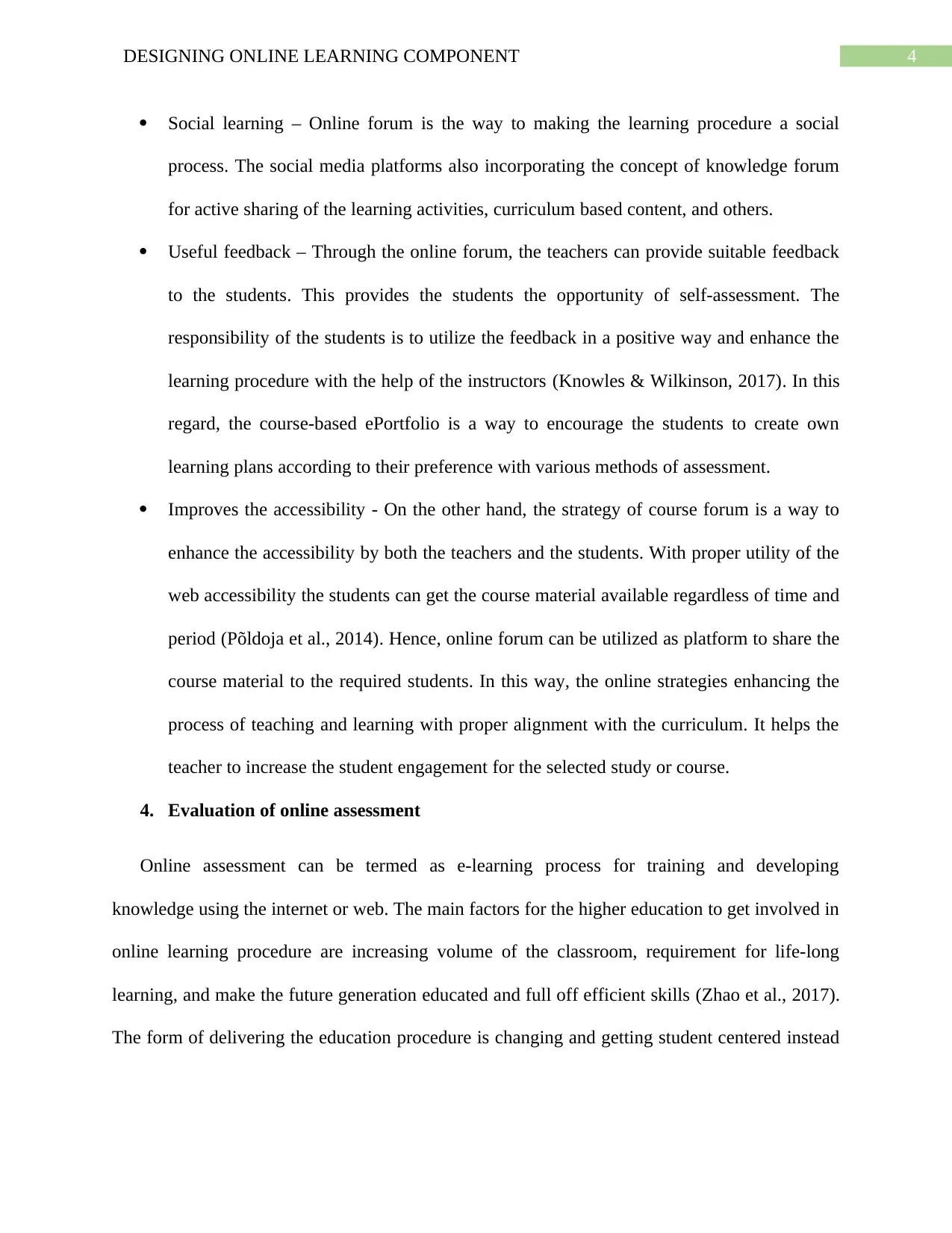
4DESIGNING ONLINE LEARNING COMPONENT
Social learning – Online forum is the way to making the learning procedure a social
process. The social media platforms also incorporating the concept of knowledge forum
for active sharing of the learning activities, curriculum based content, and others.
Useful feedback – Through the online forum, the teachers can provide suitable feedback
to the students. This provides the students the opportunity of self-assessment. The
responsibility of the students is to utilize the feedback in a positive way and enhance the
learning procedure with the help of the instructors (Knowles & Wilkinson, 2017). In this
regard, the course-based ePortfolio is a way to encourage the students to create own
learning plans according to their preference with various methods of assessment.
Improves the accessibility - On the other hand, the strategy of course forum is a way to
enhance the accessibility by both the teachers and the students. With proper utility of the
web accessibility the students can get the course material available regardless of time and
period (Põldoja et al., 2014). Hence, online forum can be utilized as platform to share the
course material to the required students. In this way, the online strategies enhancing the
process of teaching and learning with proper alignment with the curriculum. It helps the
teacher to increase the student engagement for the selected study or course.
4. Evaluation of online assessment
Online assessment can be termed as e-learning process for training and developing
knowledge using the internet or web. The main factors for the higher education to get involved in
online learning procedure are increasing volume of the classroom, requirement for life-long
learning, and make the future generation educated and full off efficient skills (Zhao et al., 2017).
The form of delivering the education procedure is changing and getting student centered instead
Social learning – Online forum is the way to making the learning procedure a social
process. The social media platforms also incorporating the concept of knowledge forum
for active sharing of the learning activities, curriculum based content, and others.
Useful feedback – Through the online forum, the teachers can provide suitable feedback
to the students. This provides the students the opportunity of self-assessment. The
responsibility of the students is to utilize the feedback in a positive way and enhance the
learning procedure with the help of the instructors (Knowles & Wilkinson, 2017). In this
regard, the course-based ePortfolio is a way to encourage the students to create own
learning plans according to their preference with various methods of assessment.
Improves the accessibility - On the other hand, the strategy of course forum is a way to
enhance the accessibility by both the teachers and the students. With proper utility of the
web accessibility the students can get the course material available regardless of time and
period (Põldoja et al., 2014). Hence, online forum can be utilized as platform to share the
course material to the required students. In this way, the online strategies enhancing the
process of teaching and learning with proper alignment with the curriculum. It helps the
teacher to increase the student engagement for the selected study or course.
4. Evaluation of online assessment
Online assessment can be termed as e-learning process for training and developing
knowledge using the internet or web. The main factors for the higher education to get involved in
online learning procedure are increasing volume of the classroom, requirement for life-long
learning, and make the future generation educated and full off efficient skills (Zhao et al., 2017).
The form of delivering the education procedure is changing and getting student centered instead
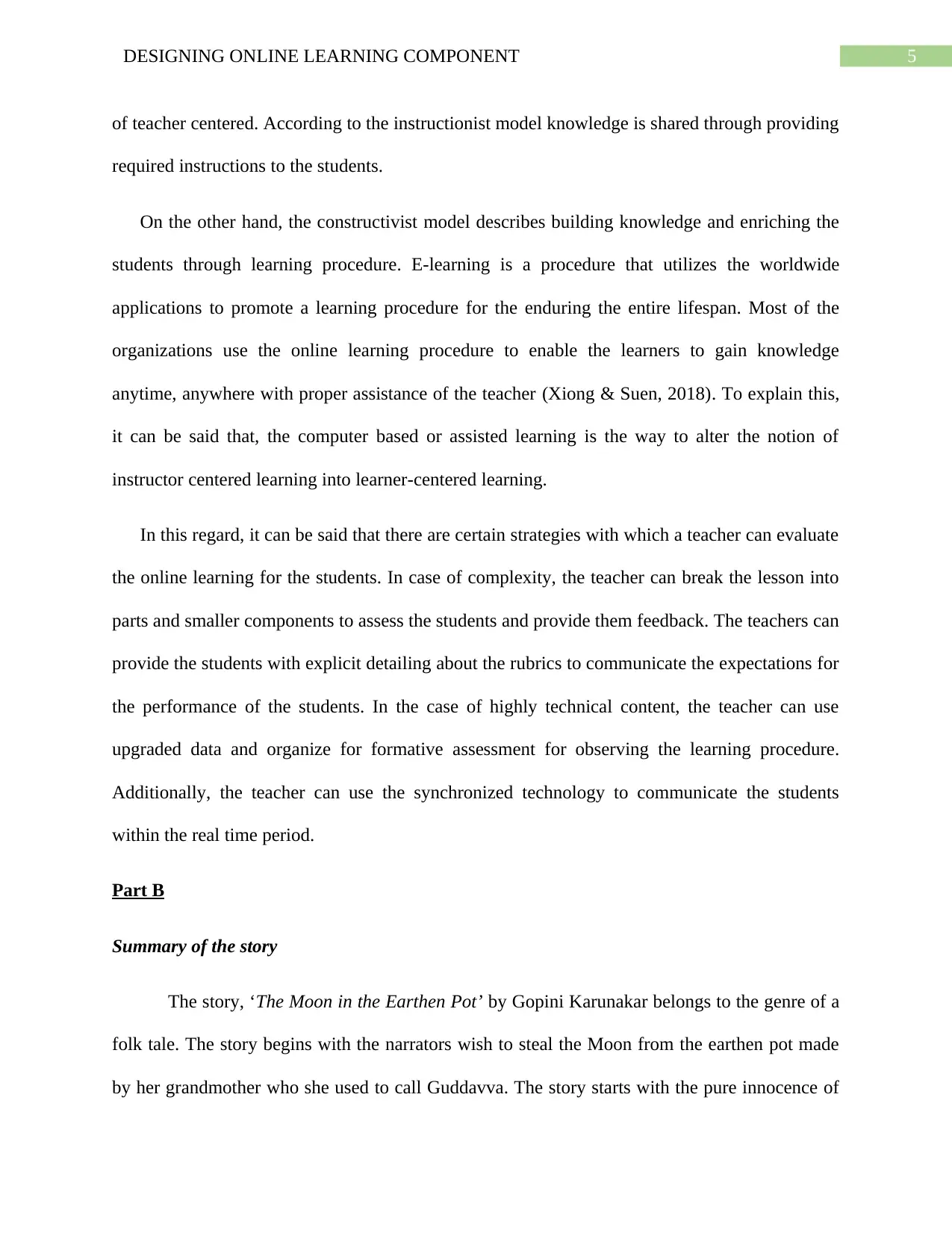
5DESIGNING ONLINE LEARNING COMPONENT
of teacher centered. According to the instructionist model knowledge is shared through providing
required instructions to the students.
On the other hand, the constructivist model describes building knowledge and enriching the
students through learning procedure. E-learning is a procedure that utilizes the worldwide
applications to promote a learning procedure for the enduring the entire lifespan. Most of the
organizations use the online learning procedure to enable the learners to gain knowledge
anytime, anywhere with proper assistance of the teacher (Xiong & Suen, 2018). To explain this,
it can be said that, the computer based or assisted learning is the way to alter the notion of
instructor centered learning into learner-centered learning.
In this regard, it can be said that there are certain strategies with which a teacher can evaluate
the online learning for the students. In case of complexity, the teacher can break the lesson into
parts and smaller components to assess the students and provide them feedback. The teachers can
provide the students with explicit detailing about the rubrics to communicate the expectations for
the performance of the students. In the case of highly technical content, the teacher can use
upgraded data and organize for formative assessment for observing the learning procedure.
Additionally, the teacher can use the synchronized technology to communicate the students
within the real time period.
Part B
Summary of the story
The story, ‘The Moon in the Earthen Pot’ by Gopini Karunakar belongs to the genre of a
folk tale. The story begins with the narrators wish to steal the Moon from the earthen pot made
by her grandmother who she used to call Guddavva. The story starts with the pure innocence of
of teacher centered. According to the instructionist model knowledge is shared through providing
required instructions to the students.
On the other hand, the constructivist model describes building knowledge and enriching the
students through learning procedure. E-learning is a procedure that utilizes the worldwide
applications to promote a learning procedure for the enduring the entire lifespan. Most of the
organizations use the online learning procedure to enable the learners to gain knowledge
anytime, anywhere with proper assistance of the teacher (Xiong & Suen, 2018). To explain this,
it can be said that, the computer based or assisted learning is the way to alter the notion of
instructor centered learning into learner-centered learning.
In this regard, it can be said that there are certain strategies with which a teacher can evaluate
the online learning for the students. In case of complexity, the teacher can break the lesson into
parts and smaller components to assess the students and provide them feedback. The teachers can
provide the students with explicit detailing about the rubrics to communicate the expectations for
the performance of the students. In the case of highly technical content, the teacher can use
upgraded data and organize for formative assessment for observing the learning procedure.
Additionally, the teacher can use the synchronized technology to communicate the students
within the real time period.
Part B
Summary of the story
The story, ‘The Moon in the Earthen Pot’ by Gopini Karunakar belongs to the genre of a
folk tale. The story begins with the narrators wish to steal the Moon from the earthen pot made
by her grandmother who she used to call Guddavva. The story starts with the pure innocence of
⊘ This is a preview!⊘
Do you want full access?
Subscribe today to unlock all pages.

Trusted by 1+ million students worldwide
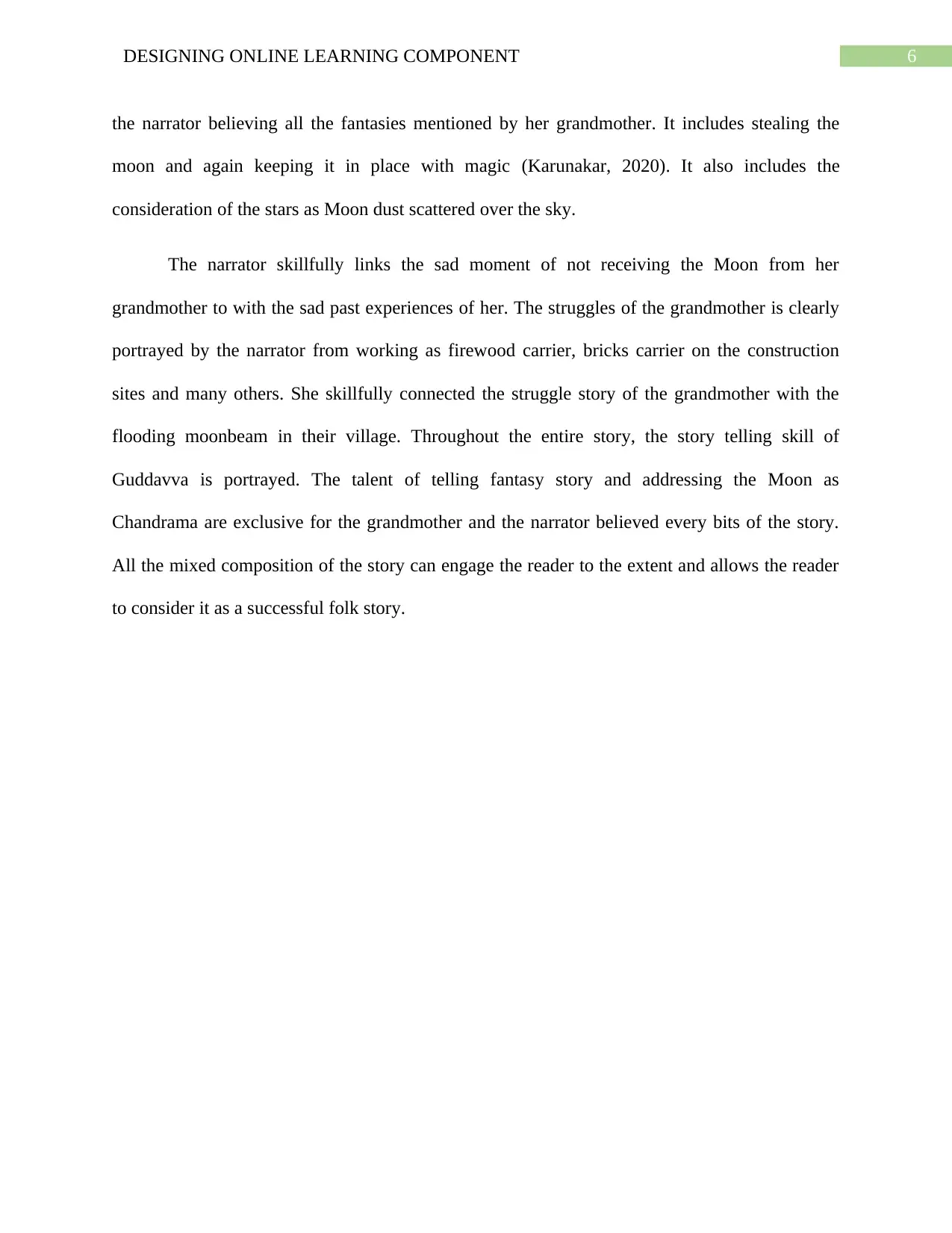
6DESIGNING ONLINE LEARNING COMPONENT
the narrator believing all the fantasies mentioned by her grandmother. It includes stealing the
moon and again keeping it in place with magic (Karunakar, 2020). It also includes the
consideration of the stars as Moon dust scattered over the sky.
The narrator skillfully links the sad moment of not receiving the Moon from her
grandmother to with the sad past experiences of her. The struggles of the grandmother is clearly
portrayed by the narrator from working as firewood carrier, bricks carrier on the construction
sites and many others. She skillfully connected the struggle story of the grandmother with the
flooding moonbeam in their village. Throughout the entire story, the story telling skill of
Guddavva is portrayed. The talent of telling fantasy story and addressing the Moon as
Chandrama are exclusive for the grandmother and the narrator believed every bits of the story.
All the mixed composition of the story can engage the reader to the extent and allows the reader
to consider it as a successful folk story.
the narrator believing all the fantasies mentioned by her grandmother. It includes stealing the
moon and again keeping it in place with magic (Karunakar, 2020). It also includes the
consideration of the stars as Moon dust scattered over the sky.
The narrator skillfully links the sad moment of not receiving the Moon from her
grandmother to with the sad past experiences of her. The struggles of the grandmother is clearly
portrayed by the narrator from working as firewood carrier, bricks carrier on the construction
sites and many others. She skillfully connected the struggle story of the grandmother with the
flooding moonbeam in their village. Throughout the entire story, the story telling skill of
Guddavva is portrayed. The talent of telling fantasy story and addressing the Moon as
Chandrama are exclusive for the grandmother and the narrator believed every bits of the story.
All the mixed composition of the story can engage the reader to the extent and allows the reader
to consider it as a successful folk story.
Paraphrase This Document
Need a fresh take? Get an instant paraphrase of this document with our AI Paraphraser
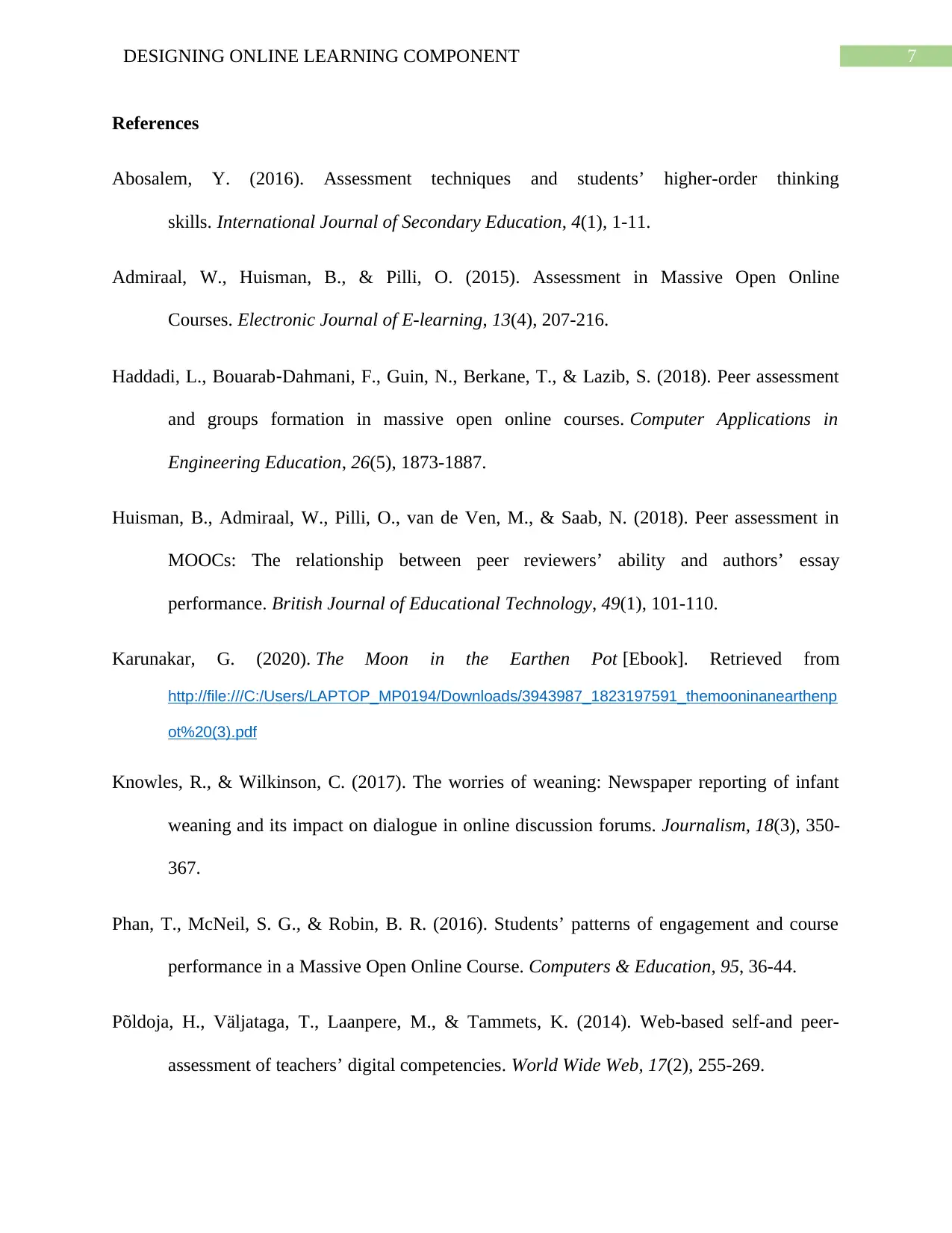
7DESIGNING ONLINE LEARNING COMPONENT
References
Abosalem, Y. (2016). Assessment techniques and students’ higher-order thinking
skills. International Journal of Secondary Education, 4(1), 1-11.
Admiraal, W., Huisman, B., & Pilli, O. (2015). Assessment in Massive Open Online
Courses. Electronic Journal of E-learning, 13(4), 207-216.
Haddadi, L., Bouarab‐Dahmani, F., Guin, N., Berkane, T., & Lazib, S. (2018). Peer assessment
and groups formation in massive open online courses. Computer Applications in
Engineering Education, 26(5), 1873-1887.
Huisman, B., Admiraal, W., Pilli, O., van de Ven, M., & Saab, N. (2018). Peer assessment in
MOOCs: The relationship between peer reviewers’ ability and authors’ essay
performance. British Journal of Educational Technology, 49(1), 101-110.
Karunakar, G. (2020). The Moon in the Earthen Pot [Ebook]. Retrieved from
http://file:///C:/Users/LAPTOP_MP0194/Downloads/3943987_1823197591_themooninanearthenp
ot%20(3).pdf
Knowles, R., & Wilkinson, C. (2017). The worries of weaning: Newspaper reporting of infant
weaning and its impact on dialogue in online discussion forums. Journalism, 18(3), 350-
367.
Phan, T., McNeil, S. G., & Robin, B. R. (2016). Students’ patterns of engagement and course
performance in a Massive Open Online Course. Computers & Education, 95, 36-44.
Põldoja, H., Väljataga, T., Laanpere, M., & Tammets, K. (2014). Web-based self-and peer-
assessment of teachers’ digital competencies. World Wide Web, 17(2), 255-269.
References
Abosalem, Y. (2016). Assessment techniques and students’ higher-order thinking
skills. International Journal of Secondary Education, 4(1), 1-11.
Admiraal, W., Huisman, B., & Pilli, O. (2015). Assessment in Massive Open Online
Courses. Electronic Journal of E-learning, 13(4), 207-216.
Haddadi, L., Bouarab‐Dahmani, F., Guin, N., Berkane, T., & Lazib, S. (2018). Peer assessment
and groups formation in massive open online courses. Computer Applications in
Engineering Education, 26(5), 1873-1887.
Huisman, B., Admiraal, W., Pilli, O., van de Ven, M., & Saab, N. (2018). Peer assessment in
MOOCs: The relationship between peer reviewers’ ability and authors’ essay
performance. British Journal of Educational Technology, 49(1), 101-110.
Karunakar, G. (2020). The Moon in the Earthen Pot [Ebook]. Retrieved from
http://file:///C:/Users/LAPTOP_MP0194/Downloads/3943987_1823197591_themooninanearthenp
ot%20(3).pdf
Knowles, R., & Wilkinson, C. (2017). The worries of weaning: Newspaper reporting of infant
weaning and its impact on dialogue in online discussion forums. Journalism, 18(3), 350-
367.
Phan, T., McNeil, S. G., & Robin, B. R. (2016). Students’ patterns of engagement and course
performance in a Massive Open Online Course. Computers & Education, 95, 36-44.
Põldoja, H., Väljataga, T., Laanpere, M., & Tammets, K. (2014). Web-based self-and peer-
assessment of teachers’ digital competencies. World Wide Web, 17(2), 255-269.
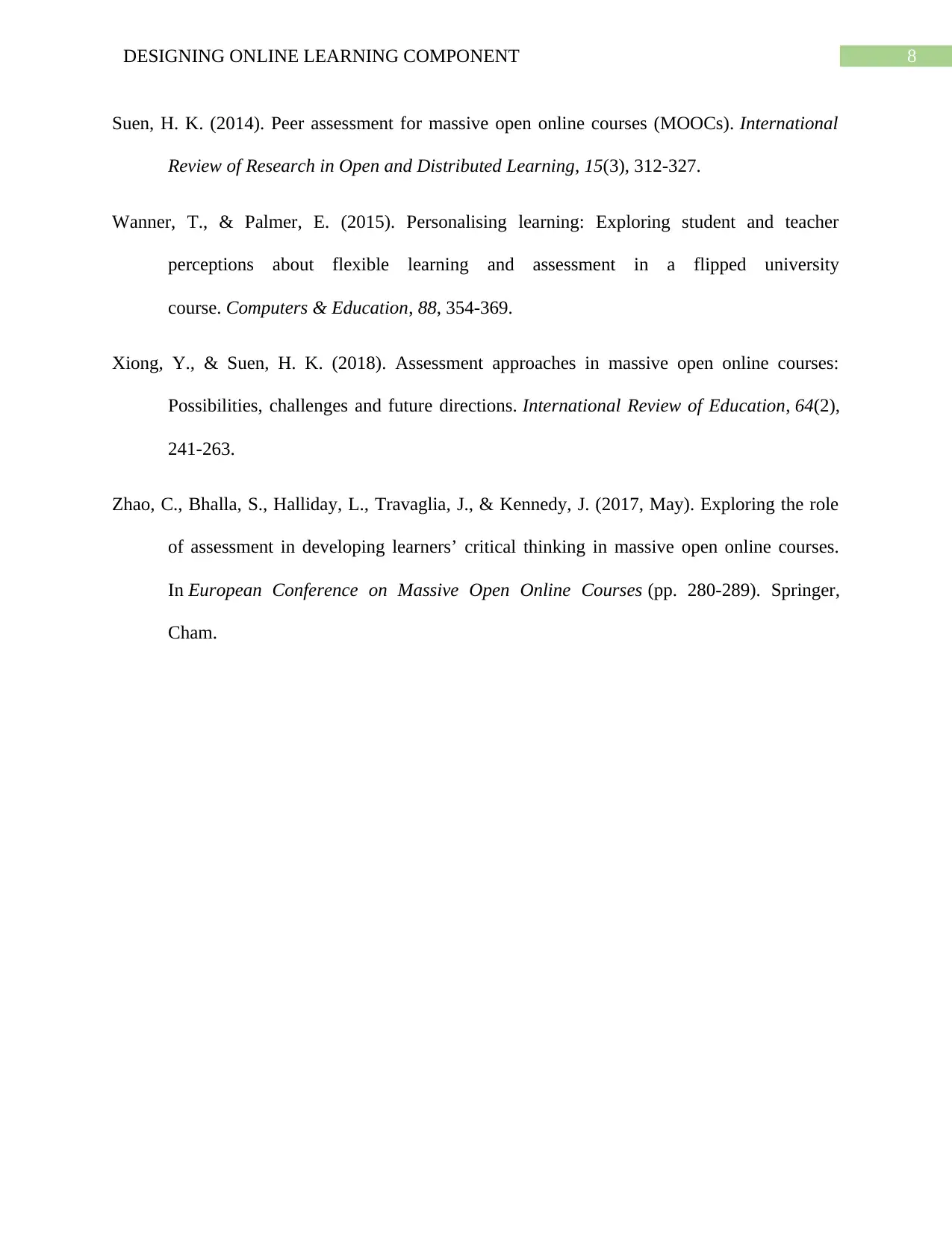
8DESIGNING ONLINE LEARNING COMPONENT
Suen, H. K. (2014). Peer assessment for massive open online courses (MOOCs). International
Review of Research in Open and Distributed Learning, 15(3), 312-327.
Wanner, T., & Palmer, E. (2015). Personalising learning: Exploring student and teacher
perceptions about flexible learning and assessment in a flipped university
course. Computers & Education, 88, 354-369.
Xiong, Y., & Suen, H. K. (2018). Assessment approaches in massive open online courses:
Possibilities, challenges and future directions. International Review of Education, 64(2),
241-263.
Zhao, C., Bhalla, S., Halliday, L., Travaglia, J., & Kennedy, J. (2017, May). Exploring the role
of assessment in developing learners’ critical thinking in massive open online courses.
In European Conference on Massive Open Online Courses (pp. 280-289). Springer,
Cham.
Suen, H. K. (2014). Peer assessment for massive open online courses (MOOCs). International
Review of Research in Open and Distributed Learning, 15(3), 312-327.
Wanner, T., & Palmer, E. (2015). Personalising learning: Exploring student and teacher
perceptions about flexible learning and assessment in a flipped university
course. Computers & Education, 88, 354-369.
Xiong, Y., & Suen, H. K. (2018). Assessment approaches in massive open online courses:
Possibilities, challenges and future directions. International Review of Education, 64(2),
241-263.
Zhao, C., Bhalla, S., Halliday, L., Travaglia, J., & Kennedy, J. (2017, May). Exploring the role
of assessment in developing learners’ critical thinking in massive open online courses.
In European Conference on Massive Open Online Courses (pp. 280-289). Springer,
Cham.
⊘ This is a preview!⊘
Do you want full access?
Subscribe today to unlock all pages.

Trusted by 1+ million students worldwide
1 out of 9
Related Documents
Your All-in-One AI-Powered Toolkit for Academic Success.
+13062052269
info@desklib.com
Available 24*7 on WhatsApp / Email
![[object Object]](/_next/static/media/star-bottom.7253800d.svg)
Unlock your academic potential
Copyright © 2020–2025 A2Z Services. All Rights Reserved. Developed and managed by ZUCOL.





